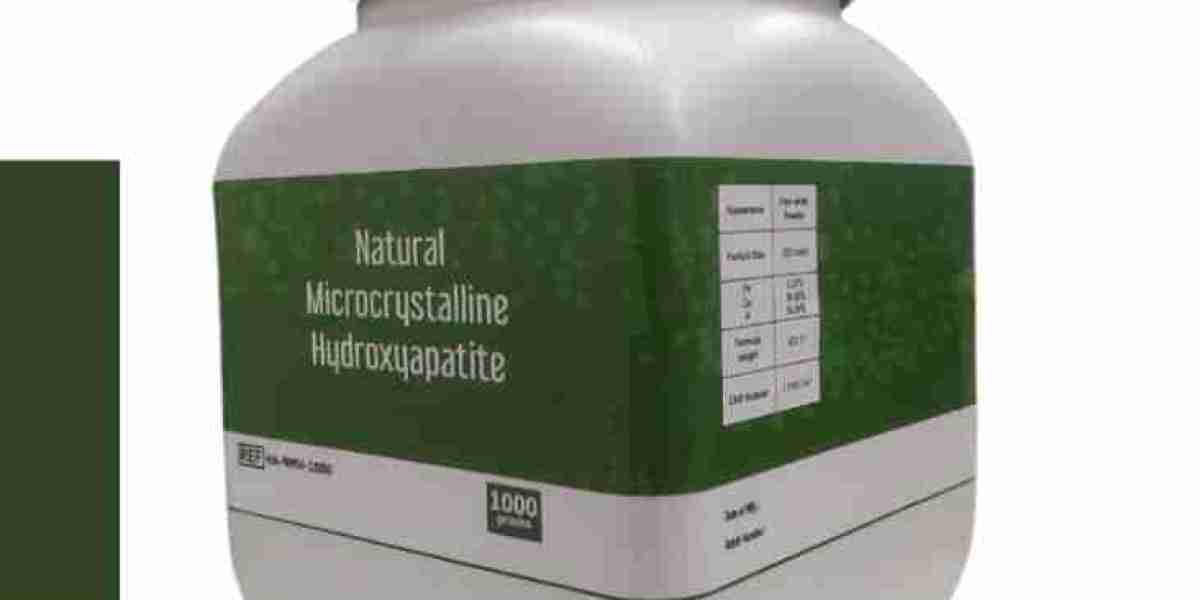Hydroxyapatite powder, which is a biomaterial extensively employed in dental and medical applications, holds a unique place in the world of science because of its chemical composition as well as the properties. When we look into the subject in this article, we will explore the intricate scientific background of hydroxyapatite, by focusing on its chemical characteristics as well as its structure and impact on various areas including bone regeneration and bioengineering.
What is Hydroxyapatite?
Hydroxyapatite (HA) is a mineral with its chemical formula Ca10(PO4)6(OH)2, is the natural chemical form that is a mineral of Apatite. Its structure is akin to the one found in human teeth and bones which makes it an important substance in biomedical sciences. In the natural world, it is located in hexagonal crystals, and it is recognized because of its biocompatibility and the resemblance to the organic bone tissue of humans.
Chemical Composition and Structure of Hydroxyapatite
The chemical structure of Hydroxyapatite powder is composed in calcium ions (Ca2+), phosphate ions (PO43-), and hydroxide ions (OH-). The repeating unit within its crystal lattice is responsible to its distinct characteristics. Each unit cell of hydroxyapatite has:
- 10 Calcium Ions (Ca2+)
- 6 Phosphate Groups (PO43+)
- 2 Hydroxide Ions (OH--)
The structure of the lattice in the hydroxyapatite crystal is extremely solid, giving it mechanical properties that are similar to bone. The presence of phosphate and calcium ions is important as these elements are the primary constituents of bone mineral and contribute to hydroxyapatite's contribution to the formation of bone and its regeneration.
Crystallography of Hydroxyapatite
From a crystallographic viewpoint from a crystallographic perspective, hydroxyapatite is an hexagonal crystal structure. This arrangement of hexagons is vital since it provides the substance with improved mechanical properties such as the stability and hardness. Furthermore the dimensions of the crystals of hydroxyapatite differ in relation to whether they're produced by synthesis or naturally occurring. In bones of humans, for instance it is present in nanocrystalline form which permits better integration into biological tissues.
Properties of Hydroxyapatite Powder
Biocompatibility and Bioactivity
A single of the significant characteristics of hydroxyapatite is biocompatibility. When utilized in medical applications, especially in bone grafts as well as dental implants, hydroxyapatite is able to create an immune response, which makes it ideal for integrating within the human body. The material's biological activity is equally crucial. Hydroxyapatite is able to bond directly with bone tissue, increasing osteoconductivity. It is the capacity of a substance to aid in the growth of bone cells.
Mechanical Properties
Although hydroxyapatite isn't as durable as other metals like stainless steel or titanium however, the mechanical characteristics are adequate for applications like the coating of implants. The strength of the compressive force of hydroxyapatite is similar to natural bone, making it a perfect option for bone replacement materials particularly in the case where the nano-structured versions are employed to replicate the natural bone mineral more precisely.
Solubility and Stability
It is believed that the fluidity of hydroxyapatite plays an vital function for its bioactivity. In water-based environments, it can dissolve slowly and release calcium and phosphate-ion ions, that are vital for bone creation. But, the solubility of hydroxyapatite is highly dependent upon factors such as the pH along with the existence of other ions. In neutral pH the hydroxyapatite remains quite stable, but under acidic conditions, like those that are found in some biological conditions, its solubility is increased.
Applications of Hydroxyapatite Powder
Bone Regeneration and Repair
Hydroxyapatite can be found as a component in osteografts as well as scaffolds to aid in bone regeneration. Due to its resemblance to osteoporosis, the bone mineral hydroxyapatite is used as a fantastic material for bone repair and renewal. When it is applied to the bone defect it functions as a scaffold, which aids in the development of new bone tissue. In time the body replaces the hydroxyapatite by natural bone, leading to a complete integration of the substance with the tissue surrounding it.
Dental Applications
In the domain of dentistry, hydroxyapatite is often utilized to aid in tooth regeneration as well as a covering to protect dental implant. The bioactive nature of hydroxyapatite make it a great material for the repair of dentin and enamel, as well as its strong affinity to bind to bone enables dental implants coated with hydroxyapatite, to bond more successfully with the jawbone.
Biomedical Engineering and Drug Delivery
Beyond dental and bone applications, hydroxyapatite has also been becoming more popular in the field of biomedical engineering. Researchers are examining the potential of hydroxyapatite in pharmaceutical delivery methods due to its capability to adsorb and release drug in a controlled way. The porous structure of the material allows an in-built storage system for therapeutic substances that are slowly released as the hydroxyapatite disintegrates within the body.
Synthesis of Hydroxyapatite Powder
The process of making hydroxyapatite powder can be accomplished using a variety of techniques, including Chemical precipitation, sol-gel processes and hydrothermal processes. Each technique has its own advantages however, the aim remains identical: create the hydroxyapatite of a specific quality that is appropriate for particular uses.
- Chemical precipitation This is among the most commonly used methods for making the hydroxyapatite. In this method, calcium and phosphate are combined in an aqueous solution and the resultant precipitate is dried, collected and calcined into the hydroxyapatite powder.
- Sol-Gel Process This process creates hydroxyapatite with the highest degree of control over particle size and high purity. It is commonly used in applications that require large surface area materials, for example drugs delivery devices.
- Method of Hydrothermal Hydrothermal synthesis involves reacting phosphate and calcium compounds at high temperatures and pressures. This leads to formation of hydroxyapatite, which has high-quality crystal structures.
Recent Advances in Hydroxyapatite Research
In recent years, research into the hydroxyapatite stone has concentrated on enhancing the mechanics as well as its biological properties. In particular, the addition of substances like zirconia or silica can increase the strength of hydroxyapatite's mechanical properties and make it more suitable for use in load-bearing. Furthermore, nanotechnology has led to the creation of nanostructured hydroxyapatite that more closely resembles the structure of bone. This results in faster integration and quicker healing.
Conclusion
Hydroxyapatite is a keystone in the field of biomaterials and tissue engineering because of its biocompatibility and bioactivity and chemical resemblance to human teeth and bone. Its unique chemical properties, its stability when in biological environment, and the ability to aid in bone regeneration make it an essential component for medical purposes. As the research progresses it is likely that hydroxyapatite will play an even greater part in the future of bioengineering and medical science.



